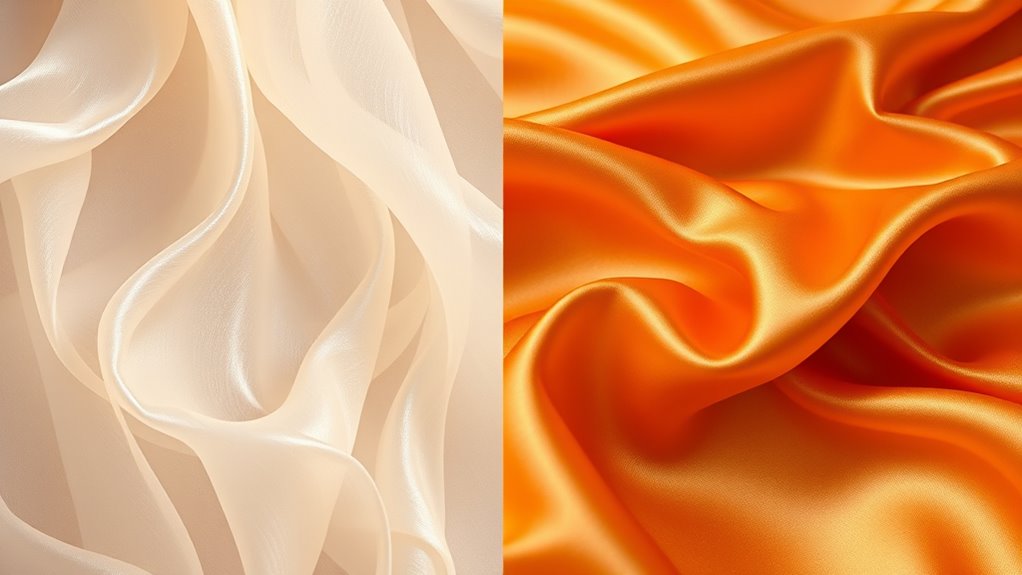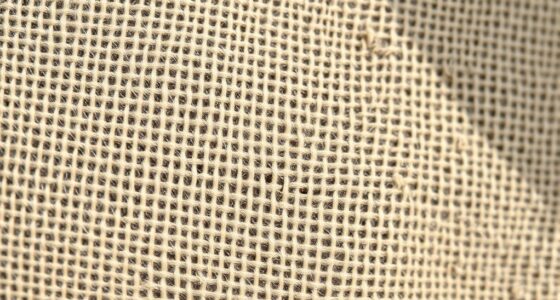Lotus silk is an eco-friendly alternative to conventional silk because it’s harvested from lotus seed stems without involving silkworm rearing or chemicals. It has a coarser, matte texture with a natural, earthy feel, making it less shiny but more durable. Traditional silk, on the other hand, offers a soft, shiny finish and polished appearance. To discover how these differences impact style, sustainable benefits, and feel, keep exploring the details behind each fabric.
Key Takeaways
- Lotus silk is harvested from lotus seed stems without sericulture, making it more sustainable than conventional silk.
- Traditional silk offers a smooth, shiny appearance, while lotus silk has a matte finish with a textured, earthy feel.
- Lotus silk production involves eco-friendly harvesting methods, reducing environmental impact compared to traditional silk farming.
- Conventional silk tends to be softer and more luxurious to the touch, whereas lotus silk has a coarser, lightweight texture.
- Lotus silk appeals to eco-conscious consumers, emphasizing sustainability, while conventional silk is prized for its polished elegance.

Have you ever wondered how lotus silk compares to traditional silk? If you’re curious about eco-friendly fabrics, this comparison offers some eye-opening insights. Lotus silk is often praised for its sustainability benefits, making it an attractive choice for environmentally conscious consumers. Unlike conventional silk, which involves sericulture—raising silkworms in controlled environments—lotus silk is harvested from the fibers of lotus plants’ seed stems. This process doesn’t require the raising of silkworms, pesticides, or chemicals, reducing its environmental footprint. As a result, lotus silk supports biodiversity and promotes sustainable agriculture. It’s a natural fiber that grows with minimal intervention, making it a renewable resource that aligns with eco-friendly values.
When it comes to texture differences, you’ll notice that lotus silk feels quite distinct from traditional silk. Conventional silk is renowned for its smooth, soft, and luxurious texture, which has made it a favorite for centuries in high-end fashion and fine textiles. Lotus silk, on the other hand, tends to have a slightly more textured surface, with a natural matte finish that gives it a unique, organic appeal. Its fibers are often coarser to the touch, but still possess a delicate, lightweight quality. Many describe lotus silk as having a more earthy, raw feel compared to the silky, polished surface of traditional silk. This textural difference can influence how the fabric drapes and feels against your skin, making lotus silk stand out as a more rustic, natural alternative. Additionally, the production process of lotus silk avoids sericulture, which further emphasizes its eco-friendly nature.
Beyond just the feel, the visual appearance of lotus silk varies as well. It generally exhibits a subtle, matte sheen, whereas traditional silk can range from shiny to semi-matte depending on how it’s processed. The texture differences extend to how the fabrics handle wear and care—lotus silk may be more prone to slight abrasions because of its coarser fibers, but it also tends to be more durable in some respects due to its natural resilience. If you’re looking for a fabric that boasts eco-friendly benefits without sacrificing style, lotus silk offers a compelling option, especially if you appreciate its rawer, more organic texture versus the polished elegance of conventional silk. In essence, the choice between the two comes down to your priorities: sustainability and a natural feel versus classic softness and shine.
Frequently Asked Questions
How Environmentally Sustainable Is Lotus Silk Production Compared to Conventional Silk?
Lotus silk is more environmentally sustainable than conventional silk because its production involves minimal chemical use and promotes sustainable practices. You’ll find that lotus silk’s environmental impact is lower since it relies on harvesting lotus stems without harming the plant, reducing ecological disruption. By choosing lotus silk, you support eco-friendly practices, helping preserve biodiversity and reduce pollution, making it a more sustainable option overall.
What Are the Unique Tactile Qualities of Lotus Silk?
Imagine running your fingers over lotus silk’s surface and feeling a gentle, almost velvety tactile softness. Its texture contrast is subtle yet distinct, offering a smooth, luxurious feel that’s softer than traditional silk. Unlike conventional silk’s often glossy finish, lotus silk provides a matte, silky touch that’s airy and lightweight. This unique tactile quality makes it perfect for those seeking a refined, sensory-rich experience with natural fibers.
Is Lotus Silk More Hypoallergenic Than Traditional Silk?
Yes, lotus silk is generally more hypoallergenic than traditional silk. If you have allergy sensitivity or are prone to skin irritation, you’ll likely find lotus silk gentler on your skin. It’s naturally less processed and doesn’t contain the chemicals or dyes often used in conventional silk, reducing the risk of irritation. This makes lotus silk a better choice for sensitive skin or allergy-prone individuals seeking a luxurious, comfortable fabric.
How Does the Cost of Lotus Silk Compare to Conventional Silk?
Ever wondered how lotus silk’s cost compares to conventional silk? You’ll find that lotus silk is generally more expensive due to its intricate harvesting process and limited supply. The cost comparison reflects pricing factors like rarity, production effort, and sustainability efforts, making lotus silk a luxury choice. While traditional silk remains more affordable, investing in lotus silk offers a unique, eco-friendly alternative that’s worth the higher price for its exclusivity.
Can Lotus Silk Be Ethically Sourced More Easily Than Conventional Silk?
Yes, lotus silk can be ethically sourced more easily than conventional silk. You benefit from better supply chain transparency because lotus fibers are harvested without harming the plant, supporting sustainable practices. This reduces concerns about animal welfare and unethical labor. When sourcing lotus silk, you can often verify its origins more effectively, ensuring ethical sourcing aligned with eco-friendly and humane standards.
Conclusion
Imagine choosing between a delicate, fleeting butterfly and a resilient, timeless oak. Lotus silk, with its fragile beauty, whispers of fleeting moments and rare treasures, while conventional silk stands tall, symbolizing endurance and tradition. Your choice reflects your story—whether you seek the ephemeral or the enduring. In this dance of fibers, remember that sometimes, embracing the rarest bloom can transform your world into a garden of wonder. The decision is yours to make.









